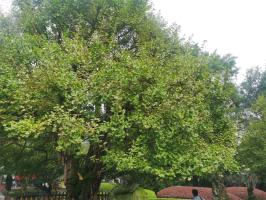Introduction
Plants are unique organisms that produce their own food through the process of photosynthesis. Photosynthesis allows plants to convert carbon dioxide and water into glucose and oxygen. In this article, we will explore the process of photosynthesis and the products created from this incredible process.
The Process of Photosynthesis
Photosynthesis is a complex process that occurs in the chloroplasts of plant cells. This process involves two stages: the light-dependent reactions and the light-independent reactions. During the light-dependent reactions, light energy is absorbed by pigments in the chloroplasts, and this energy is used to produce ATP and NADPH molecules. These molecules are used to power the light-independent reactions. During the light-independent reactions, carbon dioxide is transformed into glucose through a process called the Calvin Cycle. Water is also required during this process and is split into oxygen and hydrogen ions. The oxygen is released into the atmosphere, while the hydrogen ions are used to create ATP and NADPH molecules.
Glucose
Glucose is the sugar molecule created during photosynthesis. This molecule is used by the plant as a source of energy for various cellular processes, including respiration and growth. Glucose can also be stored in various forms within the plant, such as starch and cellulose. Starch is stored in roots and leaves, while cellulose is a primary component of plant cell walls. Plants can use these stored carbohydrates as a food source when light is not available for photosynthesis.
Oxygen
Oxygen is a byproduct of photosynthesis and is released into the atmosphere. This gas is essential for life on Earth, as it is required for respiration in animals and other organisms. During respiration, organisms take in oxygen and use it to break down glucose to produce energy. This process releases carbon dioxide and water back into the atmosphere, which can then be used by plants during photosynthesis.
The Importance of Photosynthesis
Photosynthesis is one of the most critical processes on Earth. It is responsible for producing the oxygen that we breathe and providing energy for all life on our planet. Photosynthesis is also responsible for creating the food that is consumed by herbivores, which are then consumed by carnivores in the food chain. Without photosynthesis, life on Earth would not be possible as we know it.
Conclusion
In summary, plants create glucose and oxygen from carbon dioxide and water through the process of photosynthesis. Glucose is used as a source of energy for the plant, while oxygen is a vital gas for life on Earth. Photosynthesis is a critical process that allows our planet to thrive and support a diverse range of life forms.

 how many times do yo...
how many times do yo... how many planted tre...
how many planted tre... how many pine trees ...
how many pine trees ... how many pecan trees...
how many pecan trees... how many plants comp...
how many plants comp... how many plants can ...
how many plants can ... how many plants and ...
how many plants and ... how many pepper plan...
how many pepper plan...































